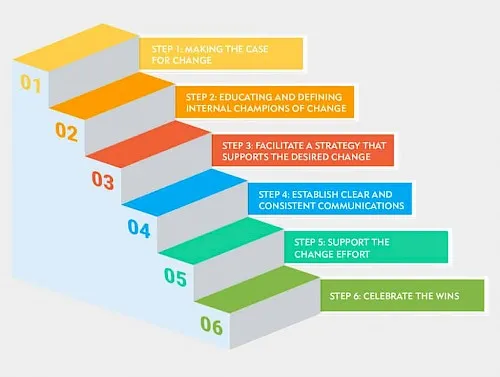The New Rules for Change Management
Table of contents

Related:
- Why Change Is So Difficult in an Office (and How to Cope)
- Silos Are Wreaking Havoc on Your Business Processes
- Better Ways to Train Your Employees for Success
In this age of rapid change and increased complexity, businesses should not expect positive changes to occur by accident. Change management has existed as a recognized discipline for about three decades and been discussed for much longer. Scholars, managers, and corporate consultants have increased their understanding of the ways that businesses can successfully change in response to evolving technology, employee expectations, economic conditions, and government regulation.
At the same time, it's easy to find examples of companies that had problems changing or simply made the wrong changes. Corporations should pause to learn some lessons from organizations that have or have not successfully transformed themselves. In time, new rules for change management can help transformative efforts support business goals and deliver promised benefits.
How Has Change Management Evolved?
Before discussing effective, modern rules for managing change, it's important to consider how change management has evolved over the years. Taking the time to learn from history can help ensure that present attitudes about business transformation are not based upon outdated ideas.
Scholars might divide historical change management into four eras:
- Businesses as machines: The first scholars who really studied businesses may have been justifiably influenced by the machines that had helped make new companies possible and old companies more efficient. Thus, they thought of their organization as a sort of machine, with cogs and wheels. Since they thought of businesses as machines, they tried to understand change management as a mechanical process.
- Businesses as hierarchies: The 1980s and 1990s heralded the dawn of the information age, even if businesses weren't quite as digitized as they are today. In those days, computers often stored information in a hierarchical structure, so change management began to focus more upon the way transformations impacted corporate organizational structures.
- Businesses as collections of people: By the 21st Century, technology and automation drove business changes even more than they had in the previous decades. At the same time, change management scholars began to recognize that companies were not just machines or organizational structures but groups of people. While more formalized change processes emerged, attempts to transform companies also focused on leadership, user experience, and the human side of companies.
- Businesses as organizations made for change: Prosci's(opens in a new tab) report upon the history and future of change management observed that organizations can prepare for inevitable changes by applying tools and processes that expedite changes and even creating positions within the organization that facilitate transformations. If businesses are machines, hierarchical organizations, groups of people, or fit all of these descriptions, it won't matter so long as they have flexibility encoded into their DNA.
The New Change Management Rules
These suggestions for managing change have been based upon real-world studies of change and an evolving understanding of why some companies manage transformations well:
1. Carefully Consider Which Changes to Make First
Harvard Business Review(opens in a new tab) estimated that most studies of transformations within companies uncovered a success rate of only about 25 percent. Failed attempts may not have worked well because they did not deliver promised benefits or were simply abandoned. The HBR report used the example of J.C. Penny's attempt to modernize their retail business.
The company first overhauled products, store designs, and prices to try to attract younger buyers. Afterward, the company's sales and stock values dropped dramatically. Looking at other retail stores that had done better, it's possible to argue that they should have begun by integrating in-store and online products and marketing first because that's what those younger buyers wanted. Customers who browsed online or inside stores had trouble finding products in the other outlet. The company continued to run their brick-and-mortar stores as a separate channel from their internet catalog.
While JCP damaged itself by making the wrong changes or changes in the wrong order, they have since worked to align business channels and have begun to recover. Making the right changes was harder because they had made the wrong changes first. The first step towards engineering successful changes is to pick the right battles.
2. Admit That Some People Will Struggle With Changes
Common expressions that describe change as the only true constant are based upon a degree of truth. At the same time, employees may have grown content with their business processes, project ownership, management, and even desks. If these same employees have to change their habits, they may protest or even actively resist.
An article in Inc. (opens in a new tab)Magazine (opens in a new tab)with good tips for managing people during change suggests taking these steps to reduce employee resistance:
- Create a company culture that understands the value of growth and innovation. Some companies proclaim the virtues of flexibility, evolution, and growth in everything from their job postings to their coffee room posters. While employees may suffer discomfort, they need to know that steps that will benefit the company will eventually benefit everybody.
- Try to predict individual employee or department reactions in advance. Some groups may have concerns over losing their authority, having to change offices, or even getting replaced by machines. If managers hope to sell changes, they will need to predict objections in order to overcome them.
- Acknowledge that some changes may impact people negatively, and it's best not to try to sell bad news as positive because that erodes trust. It's better to acknowledge issues and explain the circumstances in a matter-of-fact way.
- Some employees may never feel satisfied with changes. While management should listen, communicate, and exercise some patience, underminers need to understand they have to cooperate or find another position.
3. Use the Best Tools to Manage Change
Very often, technology causes disruptions that require corporate transformation. For instance, CIO Magazine(opens in a new tab), pointed out that AI, the IoT, SaaS, and other innovations have created opportunities for automation. While new business processes may introduce efficiencies, they might also force businesses to alter their organizations. They typically also force employees to do their jobs differently or even do different jobs.
While some advances in technology may cause disruption, such high-tech tools as workflow software will help companies manage it. These kinds of tools don't just help design business processes in a visible and collaborative way. They also document steps to help with training and even automate a lot of the work. While the best tools cannot make change management successful alone, they can provide an intuitive interface for documentation, analysis, and implementation. After implementation, workflow software can ensure that changes get understood, followed, and reported upon. For further reference, use the 6 Step Change Management Roadmap(opens in a new tab) below.

Why Companies Need to Embrace Change Now
Davor Tomašković (opens in a new tab)has the distinction of leading three companies through corporate transformations before he turned 50 years old. He says that driving change in companies that are not thriving is easier in certain respects because employees understand why they must adjust. He also found it much riskier to work with struggling companies than those that had been performing fairly well.
As in the situation with J.C. Penny, the business had already had to close stores and lost investment funds before changing their strategy. Instead of waiting for a crisis, companies should always seek to identify chances to improve. “Helping your employees create their own compelling vision of the future is the first step in awakening their motivation to change,” says Angela Dooley, educational psychologist and training professional for a U.S. federal government agency. Proactive changes will give management both more time to plan, roll new procedures out in stages, and to ensure support from stakeholders. Companies need time to ingrain innovation in their company culture, figure out which changes will offer the best value, to develop new business processes, and to select the right tools.






